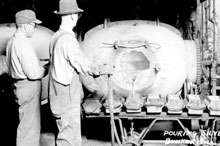No products in the cart.
Shacks and Smelter Smoke

Growing Up in Kellogg, Part Four
By John Vivian
Part Four in a series of excerpts from the author’s reminiscences of his youth, which he assembled for friends and former classmates.
Behind our house on Railroad Avenue and across the alley was what we called Vets Housing. From what I was told way back when, the one-story frame structures had been slapped together at military bases as emergency housing during World War II. After the war, the Bunker Hill Mine acquired some of them as government surplus property. My guess is they came from Fairchild Air Base or Deer Park Air Field north of Spokane or maybe the Farragut Naval Station up at Lake Pend Oreille. They were trucked to Kellogg and plunked down on timber-frame foundations along the Lead Creek, from Hill Street almost to Division Street. There must have been twenty or twenty-five of them, each a low-rent multi-family rental, all in a khaki color that matched the continual dust from the unpaved roads that wound among them. No lawns, no yards, no fences. Dogs ran loose.
My family moved from across the river to a sturdy house on Railroad Avenue in 1947, when I was two, so I never knew a time when the Vets Housing wasn’t there. To me they were part of the landscape. My only general impression as a kid was that people moved in and out a lot. Although the Vets Housing was just across the back fence, I didn’t have many playmates there. It may have been because the renters were so transient. An exception was my classmate Alan Lovell and his big brother Virgil, who were there most of my years in Sunnyside Elementary School through high school.
The Vets Housing turned out to be anything but temporary. Not until Washington Water Power built an office and yard on Hill Street, probably around 1959, were any of the buildings razed. By then, they had become increasingly shacky. Even so, most continued to be occupied. If memory serves me correctly, they were managed by Bunker as the owner and, I believe, occupancy was reserved for miners with families.
This content is available for purchase. Please select from available options.
Purchase Only
Purchase Only

